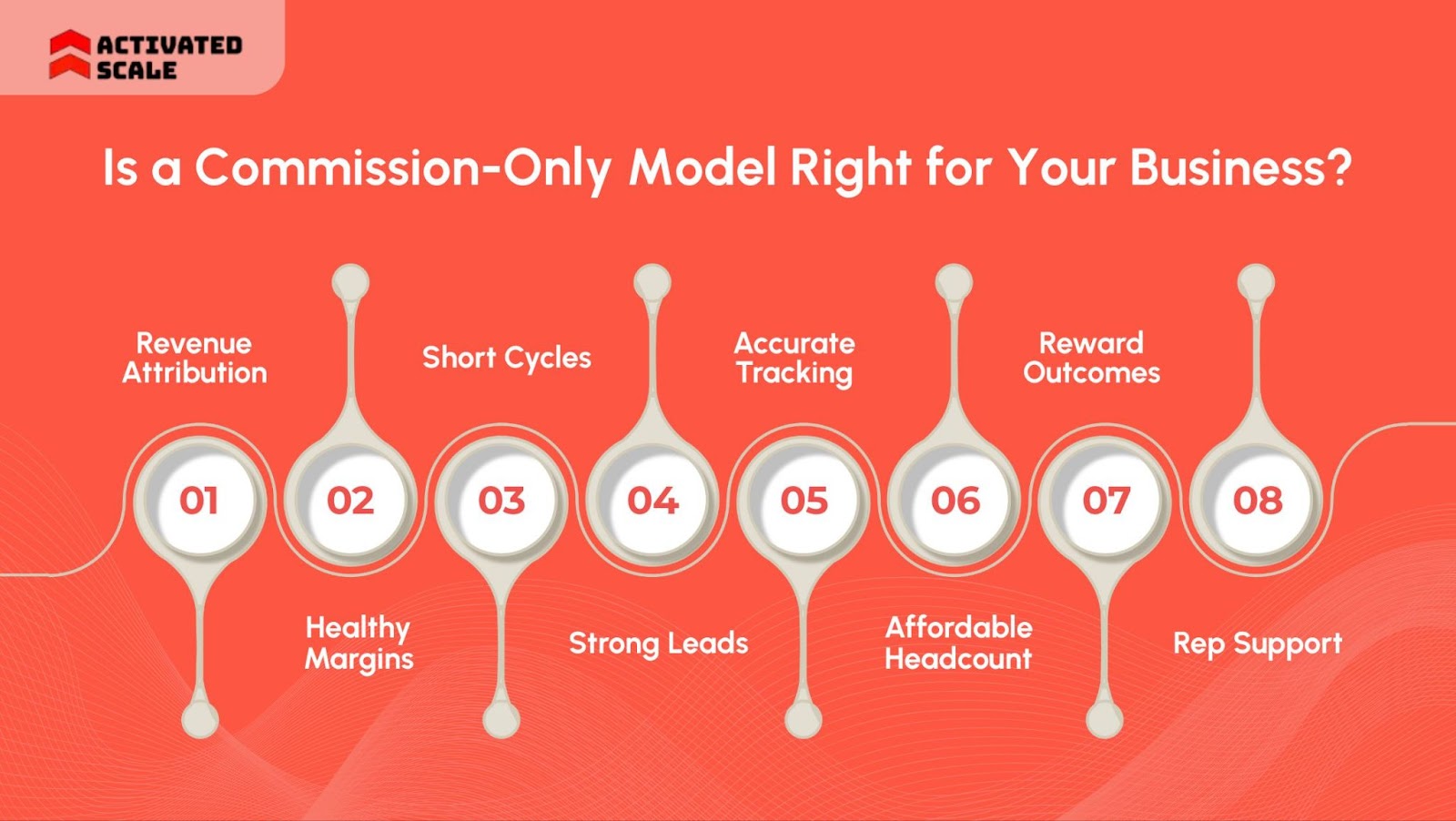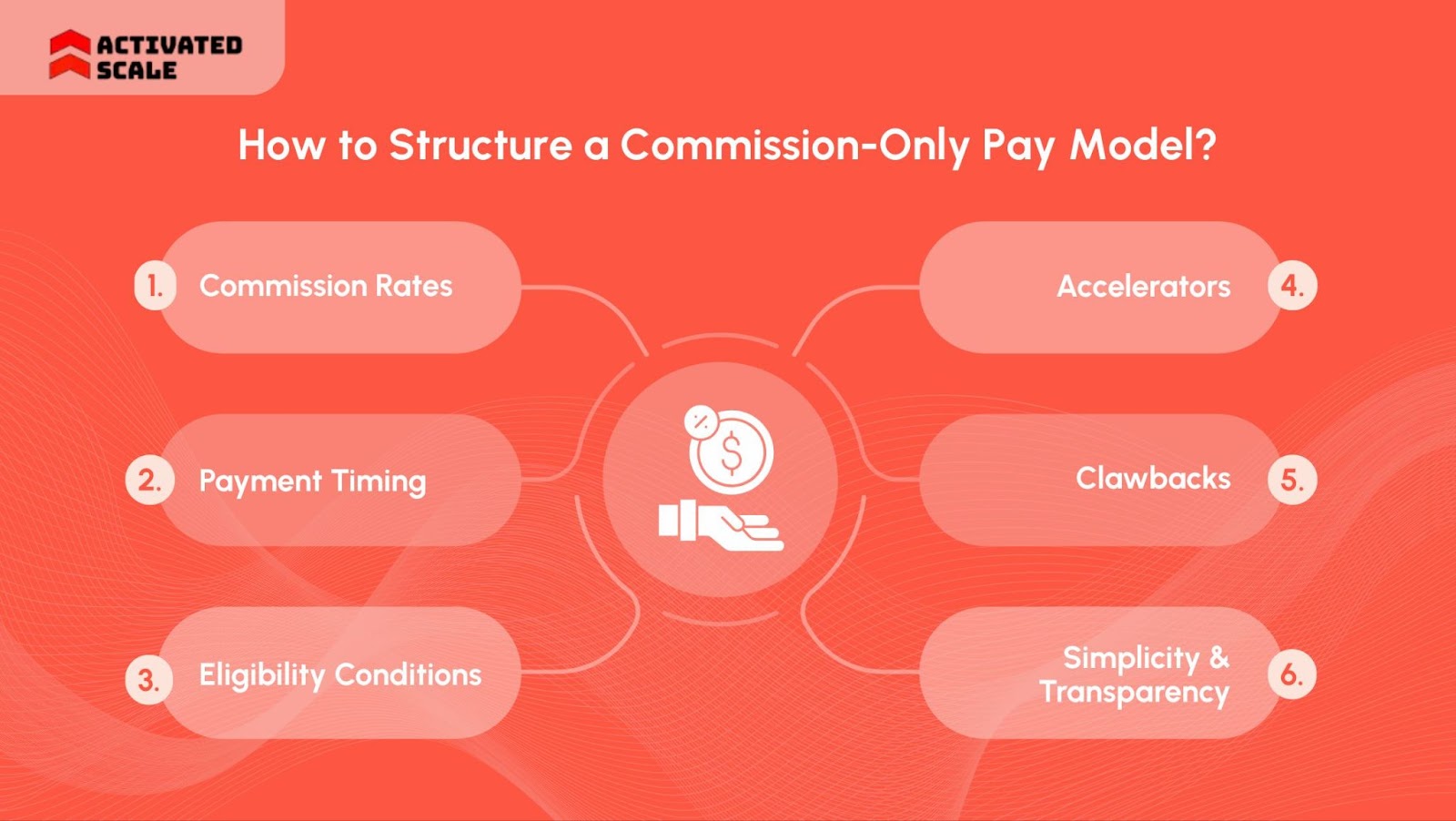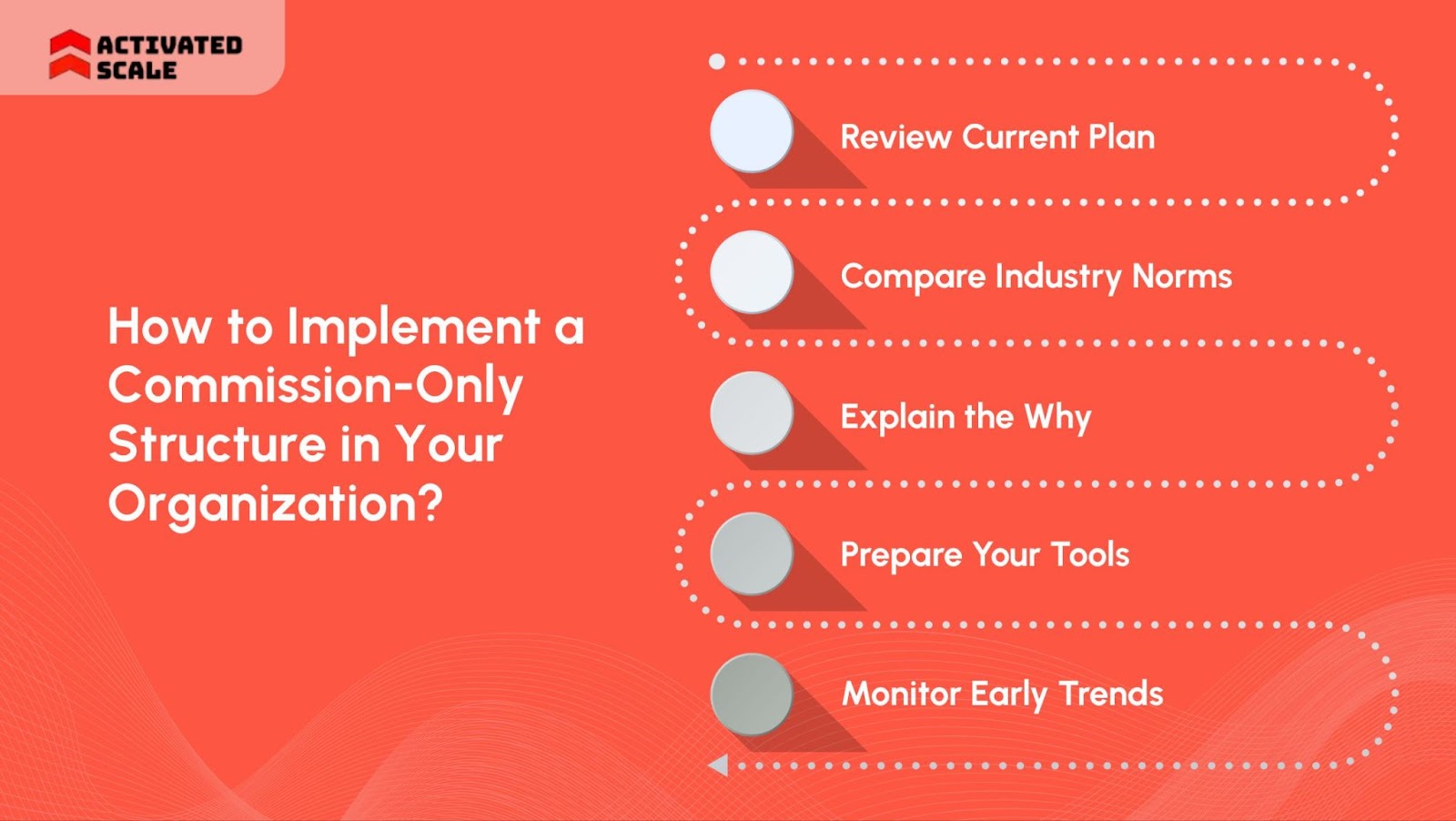"Can we cut base salaries without killing morale?" That’s the kind of question founders and sales leaders are asking more often. With budgets tighter and revenue expectations rising, the structure of sales compensation is under review.
CAC (customer acquisition cost) rose by about 14% for new customers. It indicates efficiency pressures on reps are increasing.. For many, traditional compensation models are no longer sustainable.
In this blog, we unpack the commission-only sales approach many companies are exploring. You’ll learn how it works, how to implement this commission model, and what makes it successful.
Quick Takeaways
- Commission-only sales can reduce overhead and increase accountability, but it’s not a universal fix.
- The structure must be simple, enforceable, and built around performance, not assumptions.
- You’ll need solid tools, a clear process, and rep support to avoid high churn.
- Testing the model in one role or region can reveal if it fits your sales mission.
- Partnering with the right talent source saves time, reduces risk, and validates whether this model can scale.
What are Commission-Only Sales Jobs?
Sales reps in these roles earn only when they close deals. There’s no base salary. Their earnings depend entirely on performance.
These jobs are common in industries where selling is transactional or margin-heavy, such as real estate, insurance, recruiting, and software. Companies prefer them when cash is tight or sales outcomes are easy to track.
Most reps work as independent sales reps or contractors under this model. That removes payroll complexity but adds legal and operational considerations. Commission-only sales also reshape how reps view risk, opportunity, and loyalty.
Now, the real question is, what does this model actually deliver for your business?
Also Read: Unleashing Success: A Step-by-Step Guide to Crafting a Winning Sales Commission Plan
Pros and Cons of Commission-Only Models for Companies
Commission-only sales can feel like a financial shortcut. Leaders need to weigh the short-term efficiency against the long-term sustainability of this approach.
Some businesses thrive under this model. Others struggle with retention, morale, and quality control. Knowing what you gain and what you give up, can shape how and when you roll it out.
Here’s how the trade-offs stack up:
Looking to test commission-only roles without fully committing? Activated Scale’s Contract-to-Hire Sales Recruiting lets you trial experienced reps on flexible terms, before going full-time.
If the challenges feel manageable, the next step is determining when commission-only actually makes sense. So, how do you decide if your business is ready for a compensation plan?
Is a Commission-Only Model Right for Your Business?

At least 22% of sales reps lose a deal due to poor budgeting. However, if you don’t need to choose this commission model solely to cut fixed costs. Because it will give you more than that.
Use this checklist to assess your organization’s fit. If most of these apply, testing this model could help your business scale smarter and spend leaner.
1. You can clearly tie rep activity to revenue
Commission-only models break when attribution is fuzzy. Suppose you know exactly which rep closed which deal, and when you’re in good shape. This means your customer relationship management (CRM) is set up properly, your reporting is trusted, and there’s no confusion over credit.
2. The product has healthy margins that support meaningful payouts
If the economics don’t allow for 15–30% commission per sale, reps will burn out or bail. High-margin offerings give you flexibility to reward performance while still hitting revenue targets.
3. Sales cycles are short enough to offer timely earnings
If it takes six months to close a deal, reps might go months without pay. Commission-only structures work best when reps can earn consistently, either through volume or fast turnarounds.
4. Your team has a strong lead engine or warm inbound
Commission-only reps rarely want to build their own pipeline from scratch. If your marketing funnel delivers steady, high-fit leads, reps can focus on closing instead of cold outreach.
5. You already track rep performance with accuracy
A commission-only model requires trust in your data. If you can't accurately track calls, meetings, conversions, and deal value, reps will lose confidence, and so will leadership.
6. You’re struggling to afford full-time headcount without proof of ROI
Commission-only roles reduce risk when you’re still figuring out product-market fit. If you’re not ready to commit to high salaries, this model lets you test sales hires with less exposure.
7. Your past comp plans rewarded effort more than outcome
If your previous reps hit activity goals but missed revenue targets, this model flips the script. It removes the cushion and forces focus on actual closed business.
8. You can support reps with resources, training, and tooling
Commission-only still needs to onboard reps well, give them materials that convert, and support them with tools. Otherwise, they'll churn before the first sale.
Read Also: Designing Account Manager Commission Plan: Examples and Formulas
With structure readiness confirmed, you need a pay model that’s motivating, realistic, and scalable. Because the wrong design can derail even the best rep.
How to Structure a Commission-Only Pay Model?

A commission-only sales model lives or dies by its clarity. 66% of businesses have seen a profit after starting to pay performance-based compensation to sales reps. If reps don’t understand how they get paid, or feel the plan favors the house, they’ll check out fast.
Here’s how to get it right:
1. Define Commission Rates
Start by anchoring payout to deal size or revenue. Common models include a flat percentage, tiered incentives, or role-specific rates (e.g., higher for outbound).
For example, 32% commission is standard in many software-as-a-service (SaaS) industries. Always test the math, don’t offer a rate that kills margin.
2. Align Payment Timing With Revenue Events
Some companies pay on signed contracts. Others wait until invoices are collected. There’s no universal rule, but your plan must protect cash flow and still feel fair to reps. If the collection takes months, communicate that clearly upfront.
3. Set Eligibility Conditions for Commissions
Not all closed deals should earn commissions. Define what qualifies: quota thresholds, contract terms, payment received, or minimum deal value. This avoids gray areas when deals fall through or churn early.
4. Add Accelerators for Top Performance
Tiered models reward reps who exceed targets. For example: 15% for deals under $10k, 20% for deals above. These can drive short bursts of activity and help you retain top performers.
5. Document Clawback Scenarios
If a client cancels early or defaults on payment, you might need to reclaim commissions. Spell out when and how clawbacks happen. This avoids arguments later and keeps reps aligned with retention goals.
6. Keep the Plan Simple and Transparent
If it takes more than two slides to explain, it’s too complicated. Sales reps need to understand what they earn and why. Avoid exceptions, fine print, or overly complex multipliers.
Not sure how to build a compensation plan that reps trust? Activated Scale’s Fractional Sales Leadership gives you access to experienced sales executives who’ve built high-performing teams from the ground up.
The structure only works when people buy into it. The way you introduce this model can make or break its impact on both performance and retention.
How to Implement a Commission-Only Structure in Your Organization?

A commission-only model won’t work if it’s dumped on a team without context or support. Success depends on how you introduce the change and what foundation you lay behind it. In the past year, 66% of companies have either overpaid, underpaid, or made both types of errors in commission payouts.
To avoid this, here are five clear steps to implement this model with precision and buy-in.
1. Review Current Plan
Take a hard look at how your reps are paid now. Are you rewarding revenue or rewarding effort? Are quotas too soft, or too disconnected from outcomes? If reps aren’t delivering under your current plan, a variable model may push the right behaviors.
2. Compare Industry Norms
Don’t create your comp plan in a vacuum. Study similar companies by stage and sector. See what they’re offering in terms of percentage, payout timing, and role structure. Staying competitive matters more than being generous.
3. Explain the Why
You can’t assume people will just accept a big comp change. Walk the team through the logic. Share how this model benefits reps who deliver, and what support will help them succeed. Open the floor for honest feedback.
4. Prepare Your Tools
No rep thrives on compensation alone. Give them what they need to perform: scripts, CRMs, and pipeline coaching. Train them like they’re earning a salary, even if they aren’t. Confidence grows with structure.
5. Monitor Early Trends
Track data weekly during rollout. Look at revenue per rep, average deal size, pipeline health, and rep engagement. Be ready to adjust, especially if strong reps start underperforming or morale shifts too far south.
Rolling out the model is one thing; tracking its actual impact is another. Without the right performance signals, even a well-built commission-only structure can be misleading.
Read Also: Sales Managers' Commission Structure
How to Evaluate the Performance of Commission-Only Sales Agents?
Total revenue alone doesn’t tell the full story. You need to know if reps are building consistent pipelines, closing well, and representing your brand the right way.
These benchmarks help you measure more than just the final number.
- Track Sales Volume: Start with closed revenue by rep. Compare this month-over-month and against role expectations. It tells you who’s delivering and who’s falling short, without excuses.
- Monitor Deal Quality: Look at average contract value and deal terms. If a rep closes volume but at discounts or short contract lengths, that’s a warning sign. Size matters as much as speed.
- Review Funnel Activity: Pipeline depth shows effort. Are reps following up? Are they advancing leads through stages? A flat funnel signals a lack of motion or disqualification too early.
- Score Client Retention: Fast deals mean nothing if customers churn. Check how long rep-driven accounts stay active. High refund or cancellation rates suggest short-term selling over fit.
- Gather Buyer Feedback: Post-sale surveys and direct client feedback reveal how reps behave during sales calls. Patterns here show who’s creating trust, and who’s just pushing deals.
- Compare Team Benchmarks: Set baseline metrics across the team. Who’s beating the average? Who’s lagging? Outliers tell you who’s figured it out and who needs help, or replacement.
Want reps who can deliver without locking in long-term contracts? Activated Scale’s Fractional Selling lets you plug in experienced senior development representatives (SDRs) who can consistently hit targets.
One Final Thought
Not every team is built for commission-only sales. But many leaders avoid it for the wrong reasons: fear of pushback, uncertainty around structure, or lack of a trusted starting point.
You don’t need to roll this out company-wide. You can test it. You can limit it to a channel, a product line, or one territory. What matters is designing it intentionally, backing it with data, and supporting your reps.
If you're rethinking how to grow your sales team without burning cash, start with a smarter model and the right partner.
Activated Scale helps companies hire and deploy top-performing sales talent without the overhead. Book a call and build a sales team that delivers your expected result.
Frequently Asked Questions
1. How do I know if my product works with commission-only sales?
If reps can close within 30–60 days and margins support 15–30% payouts, the model is likely viable. Long sales cycles or thin margins make it harder.
2. What’s a fair commission rate in B2B?
It depends on deal size and complexity, but most of the time, the average commission rate in B2B is 10%. Higher-ticket or self-sourced deals often justify higher rates.
3. Should I classify commission-only reps as contractors or employees?
Contractor status is common, but check local labor laws. If you're setting their schedule or controlling how they sell, you may need to treat them as employees.
4. How can I avoid rep churn under this model?
Train them well, give them resources, and make the plan simple. The more transparent the payout and support, the more likely they’ll stay.
The Ultimate Guide to Hiring a Salesperson!
Get the step-by-step guide to hiring, onboarding, and ensuring success!
_edi.png)




